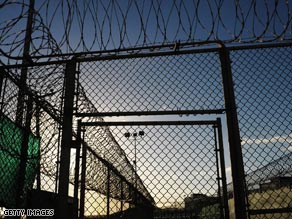
A federal appeals court panel ruled Wednesday that 17 native Chinese Muslims in military custody at Guantanamo Bay, Cuba, cannot be released into the United States.
The three-judge panel concluded by a 2-1 vote there is no legal or constitutional authority for the detainees to be immediately freed, even though they are unlawfully detained and no country is willing to accept them. The 17 men are Uighurs, an ethnic group from western China. They are accused of receiving weapons and military training in Afghanistan. Some of the detainees have been cleared for release since 2003, but the United States will not send them back to their homeland because of concern they would be tortured by Chinese authorities. The Chinese government has said no returned Uighurs would be tortured. “We do not know whether all petitioners or any of them would qualify for entry or admission [to the United States] under immigration laws,” wrote Judge Raymond Randolph. “We do know there is insufficient evidence to classify them as enemy combatants — enemies, that is, of the United States. But that hardly qualifies petitioners [the Uighurs] for admission. Nor does their detention at Guantanamo for many years entitle them to enter the United States.”
Don’t Miss
Former detainee arrested in Yemen
Gitmo’s youngest detainee
What’s next for Gitmo detainees
U.S. District Judge Richard Urbina in October ordered the Uighurs released inside the United States since they are no longer considered “enemy combatants.” He said further imprisonment “crossed the constitutional threshold into infinitum.” The Bush administration appealed, seeking a quick hearing to block any release, at least temporarily. Lawyers for the detainees now have the option of appealing directly to the Supreme Court, but the justices might not take up the matter for months. President Obama’s plans to close the Guantanamo military detention facility complicate matters further. “The government has represented that it is continuing diplomatic attempts to find an appropriate country willing to admit petitioners, and we have no reason to doubt it is doing so,” Randolph noted in the ruling. “Nor do we have the power to require anything more.” Dissenting Judge Judith Rogers agreed with the majority that it would be premature to release the detainees into the United States before their immigration status is resolved. But, she said, were it later determined their detention was illegal, the courts “would have the power to order them conditionally released into the country.” She expressed concern the men have been behind bars for years, and said their detention “appears indefinite.” About 250 detainees, many of them suspected terrorists, remain in the camp. Approximately two-thirds have appealed their continued detention and have complained the government is unfairly keeping them from finding out whether any evidence exists that could clear them of wrongdoing. Many fear arrest, physical abuse or persecution if they are sent to their homelands, according the Center for Constitutional Rights, which is representing the Uighurs in court. It said the men pose no terror threat and could be released into the United States and stay with a local Muslim community until their cases were resolved. Among the lead Uighur plaintiffs is Hazaifa Parhat, accused of attending a terror training camp in Afghanistan at the time of the September 11, 2001, attacks. He denies the charge. Urbina and Judge Richard Leon, who are handling appeals from Guantanamo detainees, have grown frustrated in recent months with the continued detention of some of the men. Leon ordered the release last week of five Algerians accused of being enemy combatants, and urged the government not to appeal. Attorney General Eric Holder said Wednesday he will travel to the Guantanamo detention center next week as a “first step” in a process to determine what to do with detainees held there. Holder told reporters after a speech on civil rights that he will make the trip to Cuba on Monday with the Justice Department’s point man on counterterrorism, Matt Olsen. Spokesman Dean Boyd termed the trip “the beginning of a review process.” Holder told reporters review of the Guantanamo detainees’ individual cases has begun and officials are “making progress,” but he declined to be more specific.








